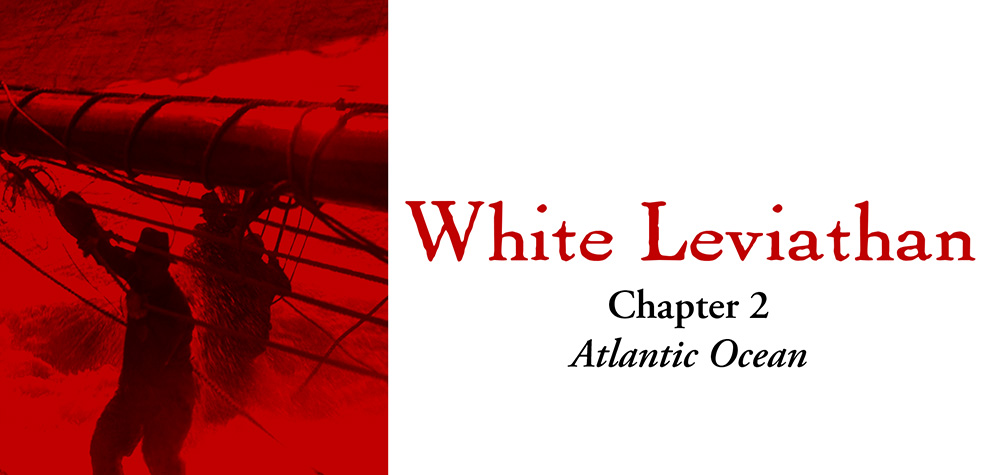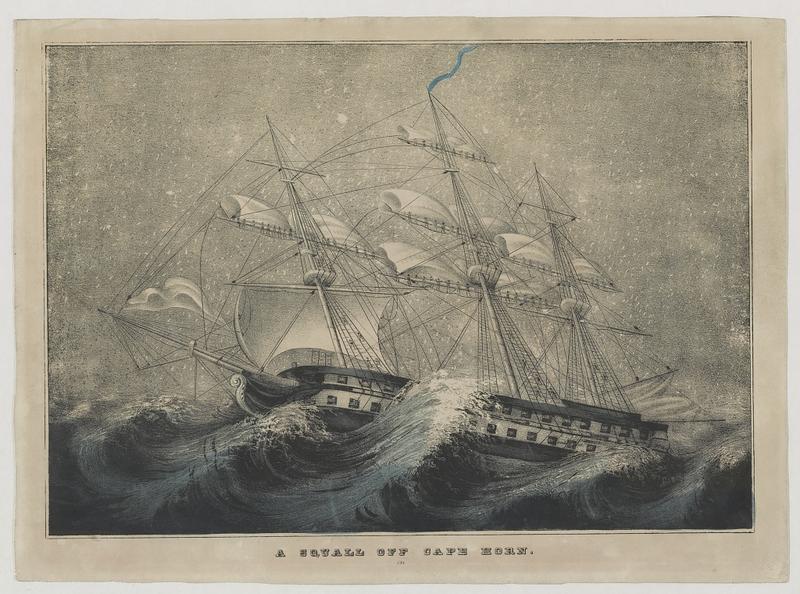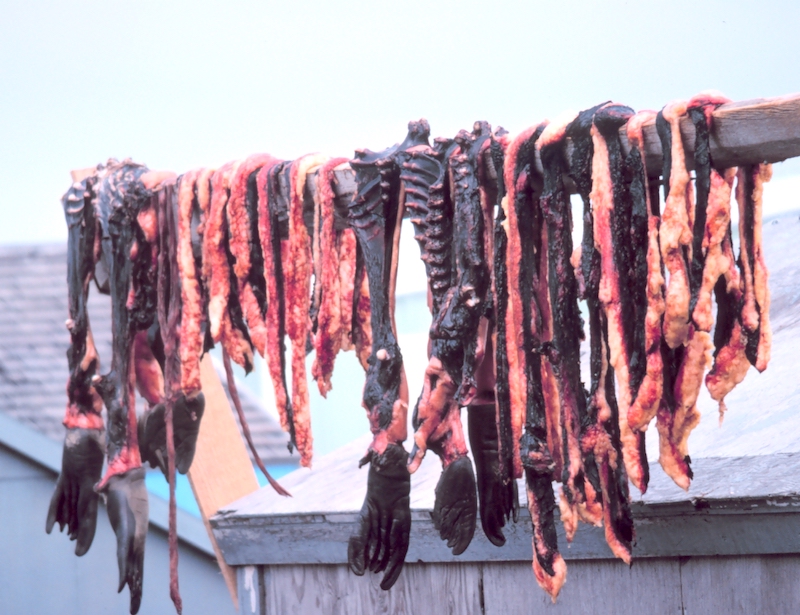Atlantic Ocean: Approaching Cape Horn
- At November 17, 2021
- By Great Quail
- In White Leviathan
 0
0
16) Approaching Cape Horn
Off the Coast of Argentina, Mid-to-Late January 1845
A) Anticipation
Once the Forties are entered, the southbound ship becomes gripped by another mood: escalating dread. After all, the Quiddity is approaching Cape Horn. And given the bad omens so far—the meteor, the squall, the lack of whales, the doldrums—things don’t look promising. But sailors love to complain, and old hands do their best to terrify greenhorns with tales of the Horn, a gossipy parade of endless storms, foundered ships, and waves reaching “a hundred feet” high. Rounding the Horn is the subject of numerous sea shanties, and Owen Love considers it his duty to sing each and every one. Whipple enjoys his war stories as well, and is fond of the old sailor’s axiom, “Below 40 South there is no law; below 50 South there is no God.”
B) Change In the Weather
As the Fifties loom closer, the temperature drops and the skies darken, occasionally bringing freezing rain or flurries of snow. The days also grow longer, with twilight lingering to 10 PM, and dawn beginning a few hours later. The night skies show the southern constellations, with the “Magellan Clouds”—believed to be nebulae—rising increasingly higher in the sky, now almost directly overhead. The humidity makes the cold even worse, and sailors complain of “never being warm.” Soon the temperature plunges below the freezing point. The rigging becomes encrusted by a rime of ice; crystalline wafers tinkling to the deck every time the lines are changed. Experienced hands break out their coats, and unprepared greenhorns are driven to the slop chest for winter gear—“monkey jackets” and shorter “baboon jackets” sold at greatly inflated prices, to be deducted from their lay at the end of the voyage.
C) Change In the Wildlife
The southern Atlantic is populated by numerous wonderful animals, all of which are happily slaughtered by whalers. Penguins make their first appearance, squealing with chilling noises that resemble human cries. (The Keeper may introduce penguins by startling the morning watch with their shrill screams as they bob near the ship. Inexperienced sailors have been known to believe a man has fallen overboard.) Gulls and gannets wheel above the yardarms, and seals sport in the water, honking in nearly-human voices. Boobies occasionally eye the sailors warily, and albatrosses become more common. The speckled haglet, or “Cape pigeon,” also follows the ship, “skimming along over the boisterous sea with his little web feet.” (Olmsted again.)
| The Albatross Despite the fate of the sailor in Coleridge’s Rime of the Ancient Mariner, whalers have little problem killing and eating “goney birds!” (It’s actually petrels that are bad luck to kill, as it’s believed they predict storms.) In fact, one popular diversion is “fishing” for albatross. In this activity, a piece of greased pork is placed on a hook and allowed to troll behind the ship on a cod line. A float is attached to prevent the bait from sinking. If the albatross takes the bait, his beak may become hooked, and the bird reeled in like a fish! It’s reputed to take some degree of skill, as the albatross is a crafty bird, easy made suspicious. (A Hard Survival roll may do the trick.) Albatross may be eaten—it’s said to taste like veal—but its lack of a gizzard makes some superstitious sailors pass over the meat. However, not all goney birds are slaughtered and eaten. A popular whaler’s diversion is to tie an inscription around captive albatross’ neck with a leather thong. These inscriptions boast the name of the whaling vessel, along with some ridiculous claim of its success—“Quiddity, Kingsport. January 24, 1845. 3 mos. out, 237 bbls. Sp. Oil.” The birds are then released to bear their message skyward. Another game whalers play with goney birds occurs during the trying-out process, when the hungry birds arrive to claim their share of the carcass. The amused sailors tie a piece of blubber to a string and toss it out for the birds to swallow, then pull it back up, taking great amusement in the baffled struggling of the ensnared creatures. |
D) Change In the Blacksmith
Soon after the temperature drops, Morgan finds himself shivering more than usual. It’s the Change, perhaps combined with his bayou blood. The cold is virtually intolerable! More troubling than this, the dreams double in intensity, and his body becomes wracked with pain. The Keeper should pull Morgan aside and privately discuss the Change: Is Morgan willing or unwilling? (See “Morgan’s Transformation” under “Player Character Secrets and Development.”) If Morgan has already made his “peace” with the sea during the rudder repairs (Encounter 9 above), suddenly deciding he’s unwilling has the effect of inflicting a –1D10 penalty die to his eventual Sanity roll. The Change itself should be resolved during Encounter 17.
E) The Falkland Islands
The Falkland Islands are sighted on January 26, 1845. (Which is also Rachel Ward’s 20th birthday!) The Falklands are known for their mixed-race population of fishermen and their once-prodigious population of seals, now mercilessly whittled down by American hunters. The islands have undergone numerous changes in government, bouncing between the French, the British, the Spanish, and more recently, the Argentines. In 1831 the Argentine “civil commander” of the Islands seized three American vessels in an attempt to regulate sealing rights. The USS Lexington was dispatched, and the United States declared the “pirate” government dissolved. Currently, the Falklands are a Crown Colony of the United Kingdom, host to a colony of Scottish farmers.
Old Dutch & Romana
One of those American vessels seized was the Breakwater, a Kingsport whaler owned by the Illsley family. And Peter Veidt was one of its crew, a 33-year old topmastman. Not only does this provide an interested Keeper with a good story—details may be found by looking up the Falklands Expedition of 1831—but Old Dutch married a Spanish woman named Romana, who still lives on the Island. While Dutch hasn’t seen her since the Quiddity stopped over in 1839, he still thinks of her fondly, and may be seen gazing at the islands longingly. He may even write her a love letter and toss it overboard in a bottle.
F) Seal Hunt
If the Keeper wants to inject some bloodlust into the narrative, perhaps a strong wind pushes the Quiddity near some rocky outcropping populated by a colony of South American fur seals? Already hunted to scarcity by American whalers, these fur seals present a rare opportunity to acquire cheap fur, along with some blubber and meat.
Because it’s unlikely Joab would halt the Quiddity for such small prey, the Keeper may rule that the “strong wind” actually cracked a weakened topmast; or perhaps the outcropping features an abandoned whaleboat, a possible replacement for one lost by the Quiddity during the Tempest? In any event, the Keeper should create some valid reason for Joab to drop anchor for a couple of hours. Pynchon orders Mr. Coffin to gather a crew and capture a dozen seals—“The fur will come in handy as we round the Horn. And you can eat the meat, too.” Obviously harpooneers should be included, but Beckett and Redburn may tag along as squires, and Dr. Lowell may be interested in observing the creatures up close.
As they row to the small island, Shaw tells the story of the Polaris shipwreck—“Aye, Mr. Pynchon knows all about eatin’ seal. After the ice took the Polaris, the bugger survived four weeks on the frozen sea. That’s why he’s so cold, shipmates. He’s got icewater in his veins…” (See Pynchon’s Character Profile for details.)
Well I’m an inshore man/and nobody’s hero…
Seal hunting is not a particularly sporting diversion. The baffled creatures barely resist, and spend their last moments honking, screaming, and dying. They may be harpooned, but seeing as their fur is their most valuable commodity, a boat hook is generally used to bash in their skulls. A few combat rolls give the hunt a thin veneer of respectability, but this is slaughter in its most unappeasable form. In the end, the carcasses are brought onboard the Quiddity to be skinned and butchered. A trypot is fired up, and the blubber is rendered to cheap oil for the forecastle. The fur is much more valuable, and is used for jacket lining, hats, and gloves. The meat is hung to dry from the gallows. Greasy and gamey, seal is disliked by most sailors; but some welcome any form of fresh meat, particularly Mattashunama, Henry Swain, and Israel Reed.
After we procured about six or seven tons of eggs, killed a good many seal, shot a number of rabbits, and strung our rigging with geese, we fired a twelve-pounder carronade for curiosity, to see how many birds would rise in sight. We got up anchor, and left this decidedly capital place for food and fun.
—Dr. John Coulter describing the Falkland Islands, “Adventures in the Pacific,” 1845.
White Leviathan, Chapter 2—Atlantic Ocean
[Back to Encounter 15: New Year’s Day | White Leviathan TOC | Forward to Encounter 17, Rounding the Horn]
Author: A. Buell Ruch
Last Modified: 26 August 2023
Email: quail (at) shipwrecklibrary (dot) com
White Leviathan PDF: [TBD]



